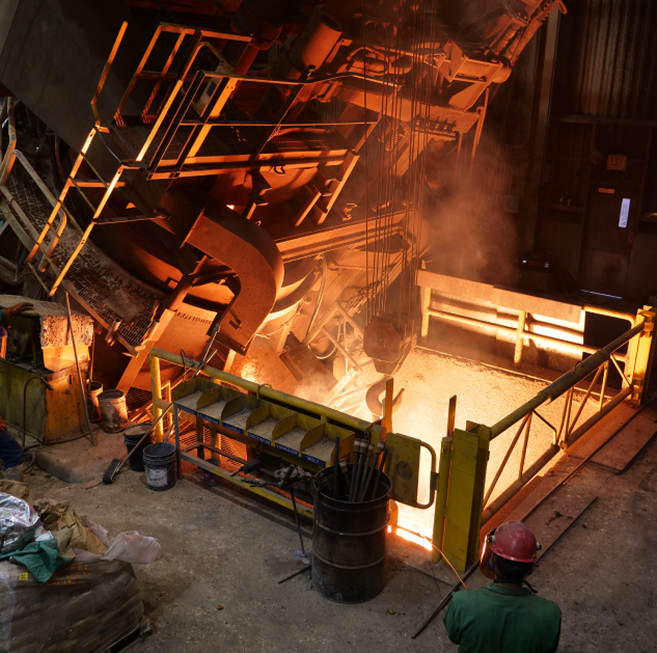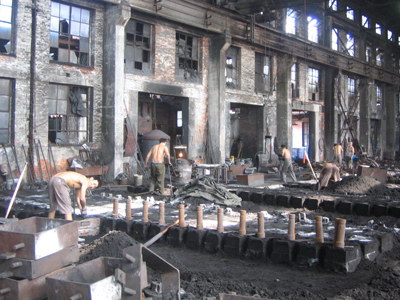How technology is reshaping modern Metal Foundry operations
Discover the Innovative Methods Utilized in a Metal Foundry for Superior Casting Results
In today's competitive manufacturing landscape, metal foundries are progressively taking on ingenious techniques to improve spreading outcomes - Aluminum Foundry. Advanced computer simulations permit accurate modeling of liquified metal behavior, while 3D printing enables fast manufacturing of complex mold and mildews. Furthermore, eco-friendly products and automation streamline procedures. These growths guarantee significant improvements in effectiveness and top quality control. The effect of these modern technologies on sustainability and manufacturing techniques remains to be fully checked out.
Advanced Computer System Simulations in Metal Casting
Advanced computer system simulations have reinvented the metal spreading procedure by enhancing accuracy and effectiveness. These advanced tools enable designers to produce virtual designs of cast parts, enabling them to forecast the behavior and analyze of liquified metal during the spreading stage. By mimicing numerous parameters such as temperature level, flow price, and air conditioning rates, suppliers can identify prospective flaws prior to physical production starts.
This aggressive method decreases waste and minimizes costly mistakes, inevitably causing enhanced item high quality. Furthermore, simulations facilitate the optimization of mold designs, making sure that they fulfill the particular needs of each job. The combination of computational fluid dynamics (CFD) and limited aspect evaluation (FEA) further adds to the accuracy of these simulations, offering understandings that were formerly unattainable. Consequently, advanced computer system simulations have ended up being a crucial component of modern-day metal foundries, considerably advancing the industry's capabilities.
3D Printing for Mold And Mildews and Patterns
3D printing has become a groundbreaking strategy for developing mold and mildews and patterns in the metal foundry industry. This technology allows the rapid production of complicated geometries that traditional manufacturing techniques have a hard time to achieve. By utilizing additive manufacturing, foundries can produce elaborate designs with decreased lead times and material waste. The capacity to generate mold and mildews as needed enables higher flexibility in style versions, helping with faster prototyping and modifications.
3D printing can make use of a selection of products, including steels and plastics, customized to particular casting needs. This adaptability boosts the accuracy of molds, resulting in remarkable casting outcomes with improved surface area finishes. Furthermore, the reduction in the variety of parts called for streamlines assembly procedures, better maximizing manufacturing efficiency. As foundries proceed to embrace 3D printing, they are poised to redefine market requirements, leading the way for innovation and boosted productivity in metal spreading operations.
Eco-Friendly Materials and Processes
As the metal foundry industry deals with increasing pressure to decrease its ecological footprint, the adoption of eco-friendly products and processes has ended up being important. Factories are currently checking out lasting alternatives to conventional materials, such as using recycled steels and bio-based binders. These materials not only decrease waste however likewise lower power consumption during manufacturing.
Additionally, innovations in sand casting methods have actually caused making use of synthetic sands that are much less unsafe to the environment. Foundries are likewise implementing innovative procedures like liquified metal therapy that decreases exhausts and enhances the high quality of actors items.
Water-based finishings have actually changed poisonous solvents, promoting a safer work environment. By incorporating these environmentally friendly techniques, metal foundries can significantly reduce their ecological effect while maintaining premium spreading results. This shift not only profits the environment but also straightens with the expanding consumer need for lasting manufacturing services
Automation and Robotics in Foundry Workflow
While the metal foundry sector accepts advancement, the assimilation of automation and robotics is changing operations considerably. Automated systems enhance processes such as mold and mildew production, metal putting, and casting ending up, substantially enhancing efficiency. Robotics assist in the handling of hefty materials, lowering the danger of workplace injuries and ensuring safer environments.

Further, the usage of automated directed lorries (AGVs) maximizes material transport important link within centers, ensuring timely delivery of parts to ideal workstations. By carrying out these modern technologies, foundries can adapt to rising and fall demands with better dexterity, inevitably resulting in enhanced profitability and competitiveness in the marketplace. As automation and robotics proceed to advance, they hold the possible to redefine traditional foundry methods and drive further advancements in casting strategies.
Real-Time Surveillance and Quality Assurance Techniques
The developments in automation and robotics have led the way for extra advanced techniques to high quality guarantee in metal foundries. Real-time tracking systems make use of innovative sensors and data analytics to track crucial specifications throughout the casting procedure. These systems constantly assess variables such as stress, material, and temperature level make-up, allowing instant detection of deviations from developed standards.
Quality control techniques now incorporate maker learning formulas that examine historical data to forecast potential defects before they take place. This positive technique lessens waste and enhances total production performance. Additionally, incorporated comments loops enable rapid adjustments, making certain that each spreading satisfies stringent high quality needs.
The execution of electronic twins-- digital replicas of physical possessions-- has also revolutionized quality control, enabling engineers to mimic and maximize processes in real-time. Together, these innovative techniques considerably boost the reliability and quality of castings, setting new market requirements in metal foundry procedures.
Frequently Asked Concerns
What Kinds of Metals Are Generally Cast in Foundries?
Commonly cast metals in foundries include light weight aluminum, bronze, brass, and iron. Each metal shows special residential or commercial properties, Find Out More making them appropriate for various applications, such as automotive components, equipment, and artistic sculptures, enhancing their convenience in production.

For how long Does the Casting Process Usually Take?
The casting process usually takes several hours to days, depending upon aspects such as the intricacy of the mold and mildew, kind of metal made use of, and cooling requirements. Each stage affects the general duration markedly.
What Precaution Are in Area for Foundry Employees?

Just how Are Defects in Castings Identified and Addressed?
Defects in spreadings are identified via visual assessments and non-destructive screening approaches. When discovered, foundry workers address them by fine-tuning processes, adjusting product structures, and applying restorative have a peek at this site actions to ensure high quality and conformity with standards.
What Is the Cost Variety for Metal Casting Providers?
The expense variety for metal spreading services generally varies in between $1 to $10 per extra pound, depending on factors such as product kind, intricacy of the layout, and manufacturing volume, impacting overall rates substantially.
In today's competitive production landscape, metal foundries are significantly embracing innovative methods to boost spreading results. As the metal foundry market encounters boosting pressure to reduce its ecological footprint, the fostering of environmentally friendly products and processes has actually come to be crucial. Foundries are currently checking out lasting alternatives to standard products, such as making use of bio-based binders and recycled metals. By incorporating these environmentally friendly methods, metal foundries can significantly decrease their eco-friendly influence while maintaining premium spreading outcomes. The advancements in automation and robotics have paved the way for a lot more innovative approaches to high quality guarantee in metal foundries.